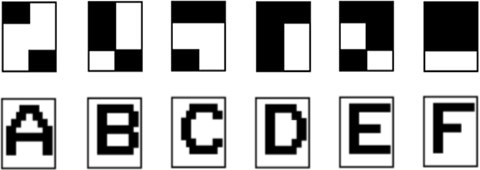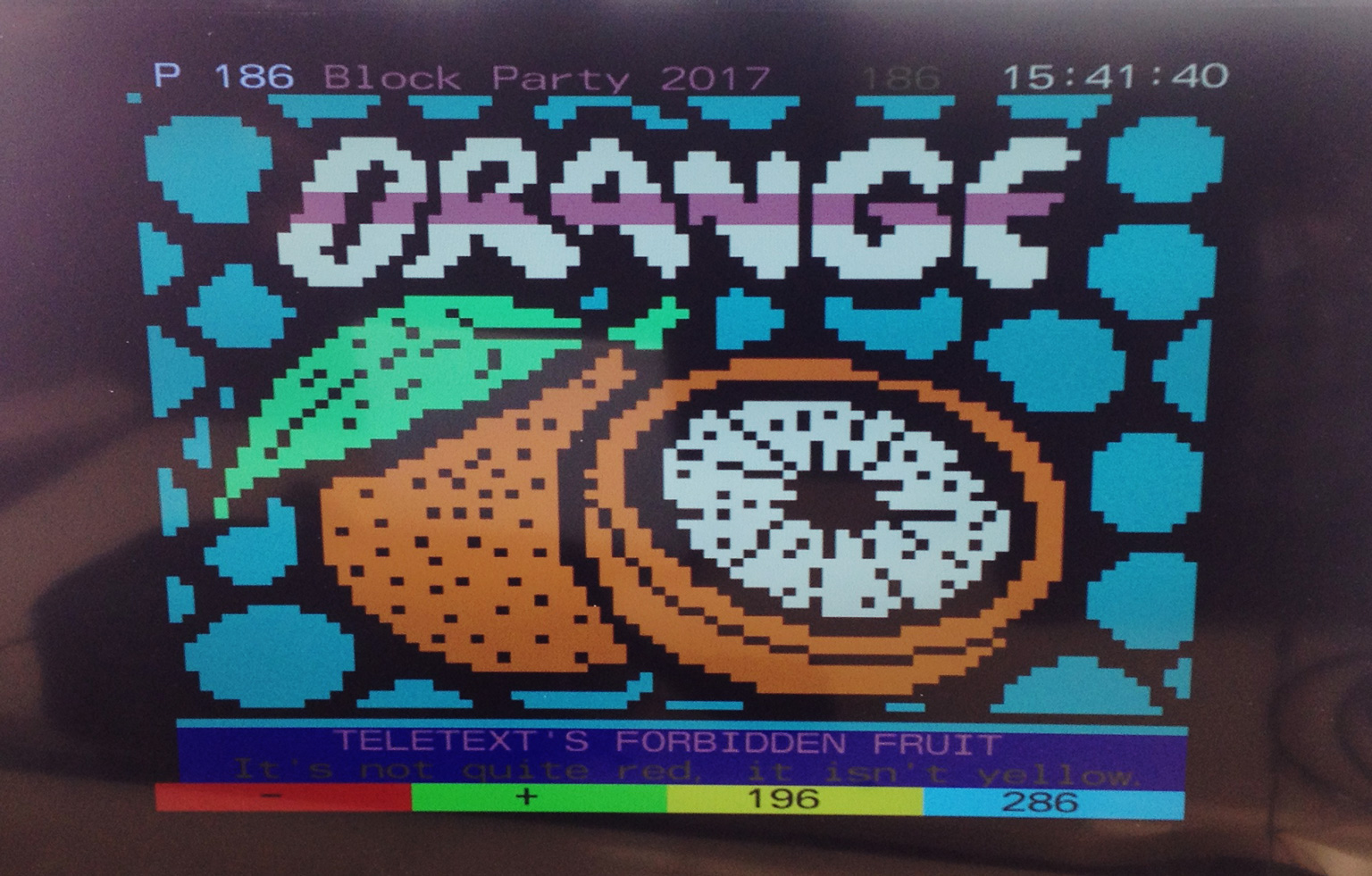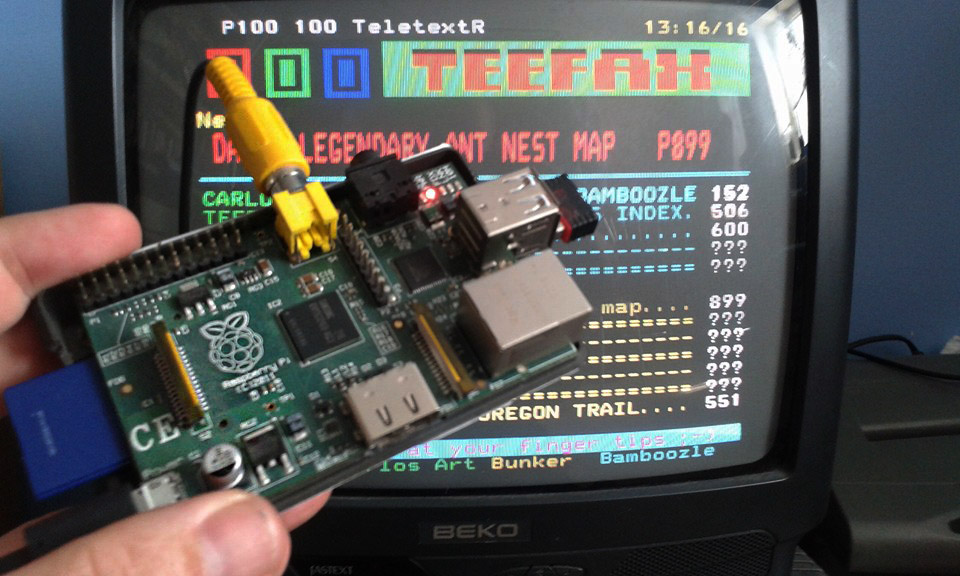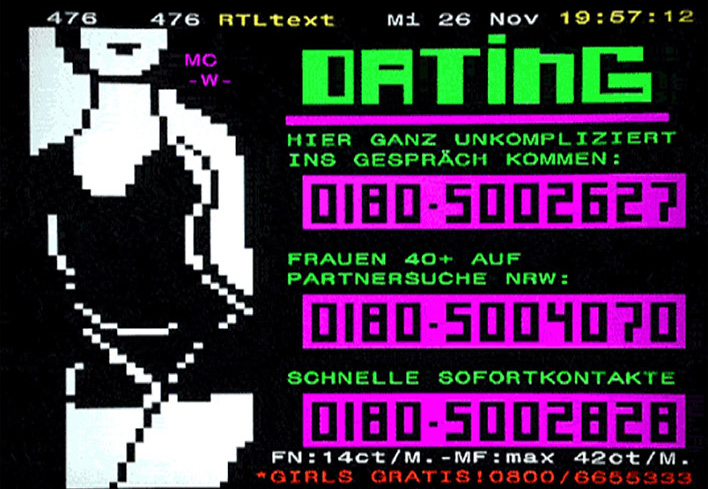"Getting the software available to all has democratised the platform."
– Carl Attrill, Facebook, 18 April 2017
Teletext is back and it's here to stay. In some countries it never went away. Broadcast engineers and a community of enthusiasts have used the free software culture of the internet to create apps like Edit-TF that bring the medium of teletext to an increasing number of interested parties, particularly artists.
 Mosaic graphics are a distinctive artefact of the technology. All the 'sixel' combinations occupy just 64 mosaic characters. This allows capital letters to remain available in graphics mode – convenient for things like weather maps. Six pixels per mosaic doesn't divide evenly, however, so the top and bottom pairs are more rectangular than middle duo. This uneven cadence is more or less unique to teletext.
Mosaic graphics are a distinctive artefact of the technology. All the 'sixel' combinations occupy just 64 mosaic characters. This allows capital letters to remain available in graphics mode – convenient for things like weather maps. Six pixels per mosaic doesn't divide evenly, however, so the top and bottom pairs are more rectangular than middle duo. This uneven cadence is more or less unique to teletext.
There's also 3-bit colour: teletext's palette of black, white, red, yellow, blue, green, cyan and magenta. The red, green and blue components of those eight colours are either full on or absent. Notably this excludes orange, which is a mix of 100% red with half-intensity green.

Orange: Teletext's Forbidden Fruit
Alistair Cree is pushing the boundaries of teletext. He's made a pastime of exploring obscure features detailed in official teletext specifications. His ZX Editor and associated tools have yielded the first enhanced teletext pages produced since unpublicised experiments by broadcasters years ago. Above is an enhanced colour page by Dan Farrimond, whose love for classic teletext extends to a feigned distaste for the colour orange.
Teletext is attractive to artists, certainly, but it still performs well when used for its original purpose. In an era when information is buried in pop-up windows, auto-play videos and other distractions, the black background and simple colours of teletext are very pleasant to peruse. Sized between tweets and blogs, teletext pages are easy to consume in either active or passive contexts: you can hurriedly click through the pages of Teefax or sit back and watch Pages From Ceefax roll by.

Teefax via Raspberry Pi
Teletext is good for the internet – and vice versa. Online systems make VBIT possible, a bit of software that brings the teletext controls of TV remotes back into service when such tellys are lashed up to internet-connected computers as shown above.
The remotes themselves, however, are dwindling in supply.

"I'm in Amsterdam right now and my hotel room TV has Das Erste. RTL has an Erotiek section. It's mostly text but there are a few funny frames with gfx. It does say the service ends on April 1st."
– Kieran HJ Connell, Teletext Slack, 27 March 2017
With Ceefax gone and cash-earners like erotic adverts starting to go, there's no question that broadcast teletext has seen better days. At one point, the MB21 Teletext Museum compiled a list of services that broadcasters made available online. Sadly, just fourteen of its 52 links worked at time of writing.
The odd teletext system can be found onscreen in betting shops or airports but the new broadcast methods of digital TV have no facility for teletext data; neither do the HDMI cables that tie together modern home video equipment.
Broadcasters like ARD in Germany and Cuatro in Spain are stalwarts of the medium, as least until Europe abandons analog broadcasting entirely. And TV manufacturers continue to make teletext gear, for now.
Teletext will never completely vanish. A community has risen around the system and new generations find it rearing its retro head from time to time, in the way telegram style occasionally pops up. It's fitting, then, to end on a few words from a fake telegram a friend sent me in 1986:
KEEP THE FAITH AND DON'T EVER STOP
Sources
Carl Attrill quote, retrieved on its publish date 18 April 2017. https://facebook.com/groups/TeletextGroup/permalink/1371949056232775
Photo: Orange – Teletext's Forbidden Fruit by Dan Farrimond, 26 February 2017. Art by Dan, rendered in enhanced teletext via the ZX Editor. https://flic.kr/p/Sv1Rp2
European Telecommunications Standard Enhanced Teletext Specification, May 1997. Retrieved 25 April 2017 http://www.etsi.org/deliver/etsi_i_ets/300700_300799/300706/01_60/ets_300706e01p.pdf
Photo: Teefax on the Raspberry Pi by Peter Kwan, 17 July 2016. Retrieved from the Teefax Facebook group 26 April 2017 https://facebook.com/teefaxText/photos/a.290797277941581.1073741827.290723167948992/290797264608249
Kieran HJ Connell quote, 27 March 2017. Retrieved 24 April 2017 from the #general channel of teletext.slack.com
Dating advert, RTLtext 26 Nov 2014. Extracted from an animated GIF in a Gizmodo article, retrieved 14 February 2017. http://gizmodo.com/the-wild-nsfw-world-of-old-teletext-porn-1685682813
Additional header images:
Iceland airport teletext by Ian Jankins. Tweet retrieved on its publication date, 17 October 2016 https://twitter.com/jenko/status/788059690706079745
What is switchover? Own work replica from BBC Ceefax retrieved 28 February 2011. http://ceefax.tv/txtmaster.php?page=697
Teletext is The Future by Steve Horsley, 30 January 2017. Retrieved 25 April 2017. https://twitter.com/Horsenburger/status/825874233880363008
Ceefax TV Room for the 21st Century: own work. Based on a well-remembered Ceefax illustration with the following modern devices added: Raspberry Pi, widescreen HDTV, blu-ray disc player and XBox 360.
Teefax home page. Own work photo of teletext by Peter Kwan. Retrieved 3 February 2017. http://teastop.plus.com:8080
